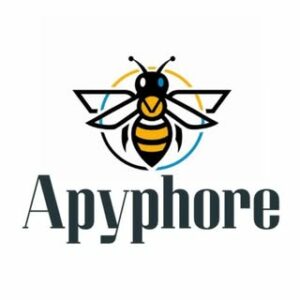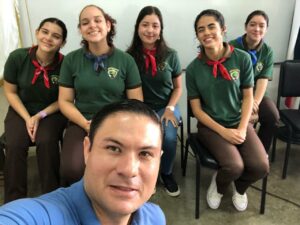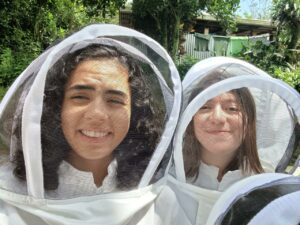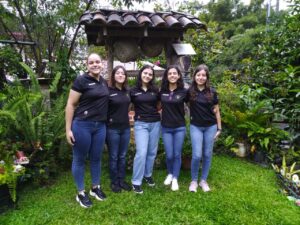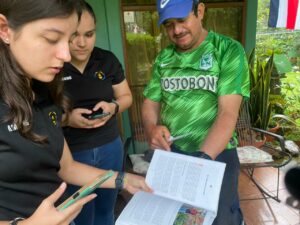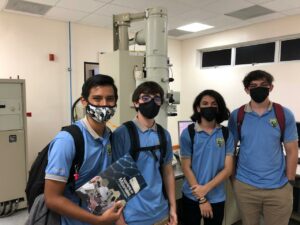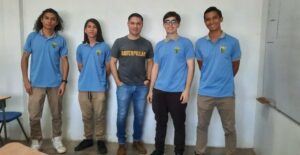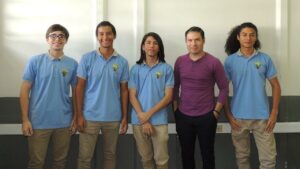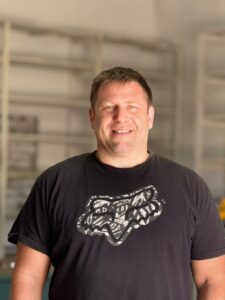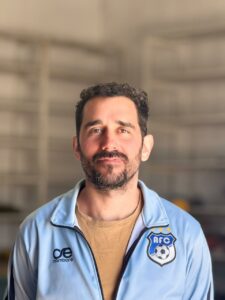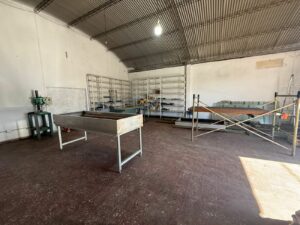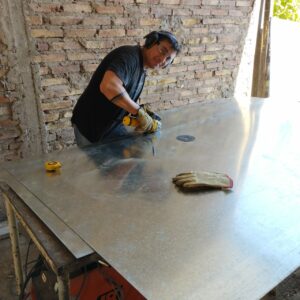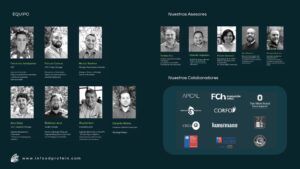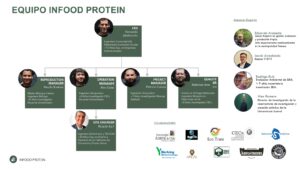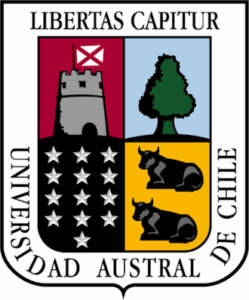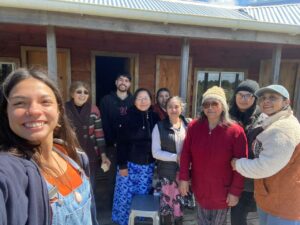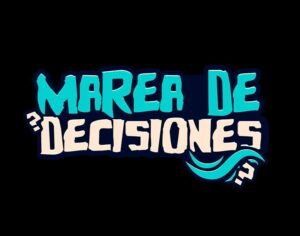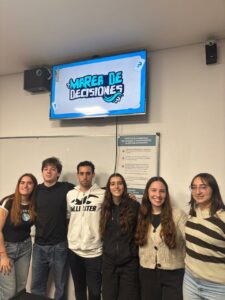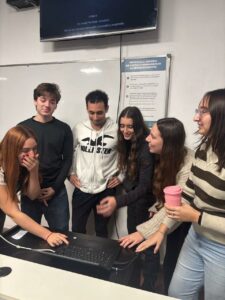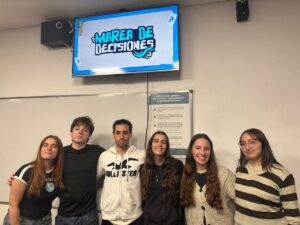
PROJECTS 2025
Finalists for the Hirmina Prize™, selected for their outstanding contribution to education for sustainability. Each reflects an inspiring commitment to innovation and the development of a more sustainable future. These are the candidates for the 2025 Hirmina Prize™:
Apyphore | Costa Rica
The project consists of a smart beehive for the extraction of apitoxin, aiming to preserve bee life and maintain the pollination process, which is vital for humans. Apitoxin, also known as bee venom, is widely used in the medical and cosmetic industries, but its traditional extraction process results in the death of 20% to 30% of the hive. Apyphore aims to protect bees. The process has two parts: one keeps the bees healthy and comfortable using things like sensors, cameras, and solar power; the other collects the venom gently using a soft shock and a special surface, so the bees are not harmed. Everything can be checked and controlled online, making it easy to use. It’s affordable, good for the bees, and helps beekeepers earn more while also protecting pollination and the environment.
This project reflects CTP de Atenas’ commitment to promoting female participation in STEM fields (Science, Technology, Engineering, and Mathematics), breaking gender barriers in traditionally male-dominated careers, and fostering women’s leadership in technological innovation processes
Apyphore currently has two units installed in apiaries located in Atenas and San Ramón, where successful tests have been conducted for the extraction of apitoxin for medical purposes without causing harm to the bees. The results obtained have demonstrated that this system allows the therapeutic benefits of apitoxin to be harnessed through ethical, innovative, and environmentally responsible technology. Apyphore not only protects biodiversity but also opens the door to new opportunities for sustainable development in the Costa Rican beekeeping sector.
Aquagraf | Costa Rica
Aquagraf is a solution designed to purify water in areas where it is contaminated, like Bagaces in Guanacaste, where around 600 people still do not have access to safe drinking water and are forced to consume water with arsenic. It’s a modular and scalable system that uses nanomaterials like graphene to remove contaminants. The system also uses IoT and Big Data to track water quality and improve how water is used in the communities where it’s installed.
The proposal is currently under review by the Town Hall of Bagaces, through the environmental manager and the local Council, who are evaluating its technical and social feasibility. The students, now at university, continue refining the prototype design with the aim of making it scalable and benefiting more than 600 people directly affected by the issue of access to potable water.
The project not only offers a sustainable alternative for water supply but also promotes public health and quality of life in the community. Challenges remain, but this type of innovative proposal represents concrete steps toward a solution.
Compact Solar Collector Project | Argentina
The project aims to develop a device that provides free domestic hot water using 100% clean solar energy. It features a compact, robust design that integrates well with architecture and is made entirely from nationally produced materials, avoiding the need for imports. Its main innovation is the combination of the collector plate and storage tank into a single unit, improving energy efficiency and lowering production costs. The system is easy to transport and install, requires minimal maintenance, and offers customisable aesthetics for seamless architectural integration. By combining functionality, accessibility, and design, it offers a sustainable solution that reduces electricity or gas use, ensures a steady hot water supply, and supports environmental and sustainability goals. This project has recently obtained governmental financial support for its development.
Regarding the product development, at the end of the month (October 2025), the final version will be installed (the one that will be commercialized) in a house in order to test its behaviour in a real-life situation.
Infood Protein | Chile
Infood Protein, in Chile’s Los Ríos Region, is a biotech start-up that transforms brewery waste (spent grain and yeast) into high-value pet food ingredients using black soldier fly larvae. At current scale (~12 tons/year), it produces approximately 0.75 t/year of insect meal and 3.6–6.0 t/year of frass, a natural biofertilizer for soil enhancement.
Black soldier fly larvae feed on organic waste, converting it into biomass rich in proteins and fats. Then, the larvae are harvested, dried, and ground to make insect meal, which is used as animal feed. Additionally, oil and organic fertilizer are produced, closing the recycling loop and reducing environmental impact.
Through the combination of insects, biotechnology, and Artificial Intelligence, the process generates sustainable ingredients, with the purpose of reducing environmental impact. Their work focuses on sustainability, circular economy, and reducing food system waste.
The estimated climate impact is a reduction of ≈6.56 tCO₂e/year ( 6.56 metric tons of carbon dioxide equivalent emissions per year. based on a carbon impact factor validated by EIT Climate‑KIC. In partnership with Ecomercado Solidario Valdivia, the project integrates local supply chains, creating both environmental and social value.
The project diverts about 12 tons of organic waste annually from landfills, producing 0.75 tons of insect meal and 4.8 tons of frass biofertilizer. This reduces greenhouse gas emissions by approximately 6.56 tons of CO₂ equivalent per year. It also lowers methane and leachate pollution while promoting nutrient recycling and reducing the need for synthetic fertilizers.
In short: less organic waste, more sustainable protein, and healthier soils—contributing to a local circular economy model.
Multi-energy micro-grids | Chile
In the Los Ríos region of southern Chile, over 1,800 homes lack electricity, limiting both quality of life and economic opportunities. This project proposes a multi-energy microgrid that combines solar, wind, and organic waste—processed through anaerobic digestion—to generate both electricity and heat. The approach leverages locally available resources from agriculture and livestock activities, producing methane gas for thermal energy and digestate for use as organic fertilizer.
The system enables rural and Indigenous communities to achieve energy independence, supporting local development through improved access to energy for food processing, agriculture, and modernized farming.
Environmentally, the solution reduces carbon emissions, recovers organic waste, limits methane release, and supports circular agriculture through local fertilizer production. It provides a more sustainable and integrated alternative to conventional rural electrification strategies.
The project has completed its initial phase and is currently seeking international funding for a second stage. A parallel initiative on Huapi Island—using the same participatory methodology—is also ready for its next implementation phase.
Tide of Decisions | Argentina
Tide of Decisions is an interactive video game aimed at raising awareness about ocean conservation, the impact of marine pollution, and the preservation of the planet’s water resources. In Marea de Decisiones, players take on the role of a governor who must implement environmental preservation measures while also considering the development of the economy, health, and well-being of a coastal city’s inhabitants.
The game promotes environmental education through an engaging and accessible format, especially targeting young people who are often disconnected from environmental discussions. By playing, users experience how imbalance in one area can trigger collapse in others, and how even small decisions can lead to larger outcomes. Ultimately, the project seeks to encourage critical thinking, environmental consciousness, and empathy through storytelling and interactivity. The target audience is adults or young adults. This decision was based on the length of the texts within the game and the reasoning process involved in decision-making. However, it could be adapted for children and adolescents.
Developed this year, 2025 and launched into production a few months ago, this game has gained significant attention for its environmental purpose, created by university students. It stands out as an innovative and interactive proposal aimed at audiences beyond children and teenagers, offering a unique way to learn about the impact of our decisions on ocean conservation. The game is available through the link shared in the bio on their social media: https://www.instagram.com/mareadedecisiones/
